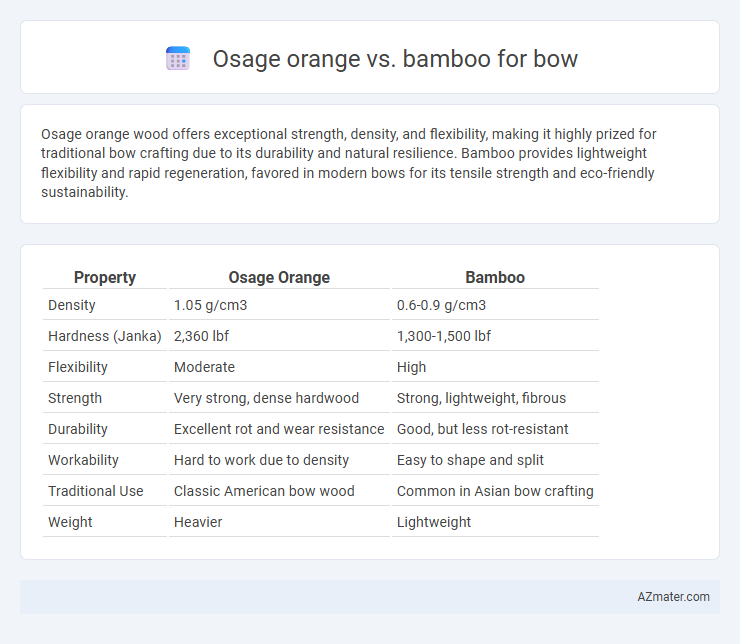Osage orange wood offers exceptional strength, density, and flexibility, making it highly prized for traditional bow crafting due to its durability and natural resilience. Bamboo provides lightweight flexibility and rapid regeneration, favored in modern bows for its tensile strength and eco-friendly sustainability.
Table of Comparison
| Property | Osage Orange | Bamboo |
|---|---|---|
| Density | 1.05 g/cm3 | 0.6-0.9 g/cm3 |
| Hardness (Janka) | 2,360 lbf | 1,300-1,500 lbf |
| Flexibility | Moderate | High |
| Strength | Very strong, dense hardwood | Strong, lightweight, fibrous |
| Durability | Excellent rot and wear resistance | Good, but less rot-resistant |
| Workability | Hard to work due to density | Easy to shape and split |
| Traditional Use | Classic American bow wood | Common in Asian bow crafting |
| Weight | Heavier | Lightweight |
Overview: Osage Orange vs Bamboo for Bow Making
Osage orange is prized for its exceptional strength, density, and natural durability, making it a preferred choice for traditional bowyers seeking powerful and resilient bows. Bamboo offers a lightweight, flexible option with excellent tensile strength, often used in laminated bow construction for added elasticity and shock absorption. Both materials provide unique advantages in bow making, with Osage orange excelling in raw power and bamboo favored for its flexibility and speed.
Wood Properties: Density, Flexibility, and Strength Comparison
Osage orange wood exhibits a high density averaging around 64 lbs/ft3, offering exceptional strength and hardness ideal for durable bow construction. Bamboo features impressive flexibility and tensile strength due to its fibrous, hollow structure, allowing for efficient energy storage and rapid recovery during bow use. When comparing, Osage orange provides superior compressive strength and resilience against torsion, while bamboo excels in flexibility and lightweight performance, influencing choice based on specific bow design requirements.
Historical Use in Traditional Archery
Osage orange wood has historically been prized by Native American tribes for traditional bows due to its exceptional strength, elasticity, and resistance to splitting, making it ideal for powerful, durable weaponry. Bamboo, used extensively in Asian archery traditions, offers lightweight flexibility and rapid recovery, providing a smooth draw and efficient energy transfer in yumi and other traditional bows. Both materials hold significant cultural importance, with Osage orange embodying Native American craftsmanship and bamboo reflecting centuries of Asian archery innovation.
Harvesting and Sustainability Aspects
Osage orange wood offers exceptional durability and natural resistance to rot, making its harvesting more sustainable due to slower growth cycles and minimal need for chemical treatments. Bamboo, renowned for its rapid growth and high renewability, can be harvested every 3-5 years without compromising soil health, significantly reducing environmental impact. While Osage orange provides superior strength for bows, bamboo's sustainable cultivation practices enhance its appeal for eco-conscious archers.
Workability: Shaping, Tillering, and Finishing
Osage orange wood is prized for its exceptional workability in shaping and tillering due to its dense, fine-grained structure, allowing precise heat bending and smooth, controlled tapering for optimal bow performance. Bamboo, while flexible and strong, requires more effort in laminating and shaping to achieve uniform tiller curves because of its natural segmented structure and variable grain pattern. Finishing Osage orange yields a harder, more durable surface with minimal sanding, whereas bamboo benefits from additional sealing and smoothing to protect against moisture and enhance longevity.
Performance: Speed, Power, and Efficiency
Osage orange offers exceptional speed and power for bows due to its high density and resilience, providing strong energy transfer and rapid arrow acceleration. Bamboo excels in efficiency with superior flexibility and shock absorption, reducing fatigue during extended use and enhancing shot consistency. While Osage orange delivers maximum power for heavy draw weights, bamboo's lightweight nature favors speed and smoother shooting performance.
Durability and Longevity in Different Climates
Osage orange exhibits exceptional durability and longevity for bows, thriving in various climates due to its dense, rot-resistant wood that withstands moisture and temperature fluctuations. Bamboo offers remarkable flexibility and tensile strength but tends to degrade faster in humid or wet conditions without proper treatment. For long-term bow performance across diverse environments, Osage orange is generally preferred for its resilience and sustained structural integrity.
Cost and Availability of Each Material
Osage orange offers moderate cost and is widely available in North America, making it a popular choice for traditional bowyers seeking durability and strength. Bamboo, while generally more affordable in raw form, can vary in price depending on quality and processing, and is primarily sourced from Asia, leading to potential shipping costs and availability fluctuations. Overall, Osage orange provides consistent local availability and reasonable pricing, whereas bamboo may require extra effort to source but can offer cost advantages in bulk or regionally.
Aesthetics and Customization Potential
Osage orange offers a vibrant, golden-yellow grain with a durable, close-grained texture that ages beautifully, providing rich visual appeal and natural resistance for bow crafting. Bamboo presents a smooth, consistent surface with distinctive nodes and a sleek, modern look, allowing for streamlined shaping and layered customization in laminated bow designs. While Osage orange excels in organic grain depth and natural coloration, bamboo stands out for its flexibility in engineered aesthetics and versatile structural modifications.
Expert Recommendations and User Experiences
Experts recommend Osage orange for bow making due to its exceptional strength, flexibility, and natural durability, which allow for powerful and resilient bows. User experiences consistently highlight Osage orange's superior performance in maintaining shape and delivering consistent shooting accuracy compared to bamboo, which is favored for its lightweight properties but often criticized for less stability and durability over time. Bowyers frequently choose Osage orange for long-term reliability, while bamboo is preferred for lightweight and aesthetic qualities in traditional or beginner bows.

Infographic: Osage orange vs Bamboo for Bow
 azmater.com
azmater.com